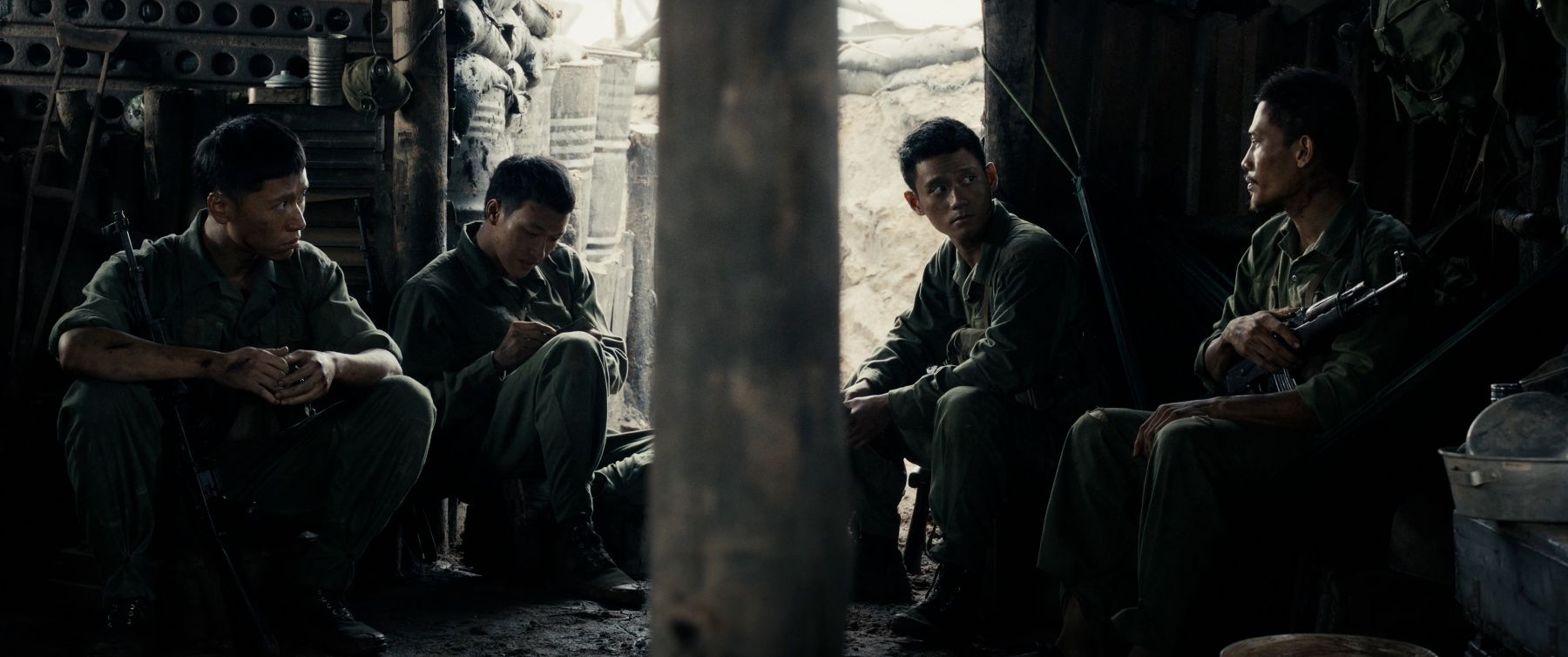In fact, in terms of content, the film Living with History is not bad, if not quite good. The film revolves around a group of young people traveling through the achievements of Dien Bien Phu in the past. Throughout their journey, they dreamed of appearing in their ancestors' battles, meeting historical heroes and transforming into meritorious people pulling in fireworks and digging tunnels for 56 days and nights. From people in the modern world, selfish and irresponsible with society, they are gradually changing in a positive direction.
The film was invested by the State with more than 20 billion VND - a large number at that time. The director, People's Artist Nguyen Thanh Van, isproficient, the script written by screenwriter Pham Minh Tuan is difficult to criticize, the female lead role of Thu Quynh is familiar. However, contrary to expectations, the number of tickets sold is only sparse. The screening room at the National Film Center where I sat to watch was only about 5 people.
In the media, People's Artist Nguyen Thanh Van explained that he does not attach too much importance to business factors but focuses on conveying historical messages to the audience. On the other hand, the film is shown in a small theater system with little competition.
Film critics pointed out another reason why "Living with History" is not widely known to the public is the poor promotion of the film, lack of market demand survey, and audience tastes. The Vietnam Feature Film Studio does not have a professional department to help the project reach many audiences.
Living with History is not an isolated incident. Some films in the same "stream" such as "Scent of the burnt grass", "Mo Gio"... were also classified as "in warehouse" films when they could not be released in theaters.

**
10 years later, when People's Artist Nguyen Thanh Van participated in "Red Rain" as an art consultant (he himself was also invited to play a small role in the film), he must have some doubts when remembering "Living with History". But time has changed. Viewer psychology and awareness have also changed and what was considered a limitation in Living with History has been corrected.
It is also necessary to say that the success of "Red Rain" is not a coincidence. Previously, "Peach, Pho and Piano" (2024) - a film ordered by the State - unexpectedly created a box office fever during Tet, with a revenue of about 23 billion VND. The film shows that if released and promoted well, political films can completely attract customers.
Next, "geography: Sun in the dark" (2025) also left its mark with revenue of hundreds of billions of VND, affirming that Vietnamese audiences, especially young people, are increasingly interested in historical stories.
Director Dang Thai Huyen, who is behind "Red Rain", shared: "The success of the seniors is a great source of encouragement. The film market is lacking films about history and revolution. The audience now, especially the young, is eager to learn about history. They want to know how their ancestors lived and fought. We simply tell that story in a modern, familiar cinematic language, and it is the audience that makes the miracle.
Experts say that the success of "Red Rain" has many resonating factors. First, the film was released at the "golden time". Amidst the heroic atmosphere of celebrating the 80th anniversary of the August Revolution and National Day on September 2, the film "Red Rain" has appeared as a special phenomenon of Vietnamese cinema.
Cinema is an art that touches the heart. "Red Rain" was released on the occasion when the whole nation commemorated the important historical days, when the spirit of solidarity and patriotism was being strongly aroused. The atmosphere of celebrating the 80th anniversary of the August Revolution and National Day on September 2 makes each audience member when entering the theater carry a special mindset. The film is not only an entertainment product, but also becomes a bridge connecting today's emotions with the heroic history of the nation.
In addition, one of the key factors that made the "Red Rain" magnificent was the special support from the Army. Military equipment and battlefield settings are recreated on a large scale, creating high authenticity and persuasion. Meanwhile, Galaxy Studio - the leading commercial release unit - has ensured to bring the film to a wide, professional and effective audience. The combination of authorization and marketness has helped "Red Rain" cross the line of a pure propaganda work, becoming an attractive cultural product for the public.
Next, "Red Rain" is adapted from the famous novel of the same name by writer Chu Lai, which has left a deep impression on many generations of readers. Bringing literary works to cinema is a big challenge, requiring preserving the original spirit but at the same time having to adjust to suit the rhythm of the film. In "Red Rain", the script was handled machantly and neatly, both recreating the true battlefield and depicting human fate. It is the solidity in the script that has helped the film maintain its tragic and touching quality while still being close to modern audiences.
Another surprising thing is that "Red Rain" does not follow the "box office star" formula, the "Red Rain" crew has chosen young faces. They are Do Nhat Hoang who received a lot of attention when playing the main role Cuong, Le Hoang Long - who played the special forces player Sen, Steven Nguyen as Quang - an officer on the other side... This decision may have initially caused many people concern, but when the film was released, the cast proved that this choice was the right one. The novelty of faces brings a more realistic feeling, making it easy for the audience to believe that they are witnessing real-life soldiers, not familiar stars on screen. This is an adventurous but wise move, contributing to the film's own appeal.
Of course, along with the novelty, there is still the maturity and experience of veteran names: People's Artist Tran Luc, Hua Vi Van, Than Thuy Ha... creating a solid support for the young cast.
"Red Rain" effectively utilizes filming technology, art and modern techniques. The scenes of fighting, smoke, and bullets are elaborately staged, both realistic and artistic. In particular, the art and costumes recreating the ancient battlefield setting have contributed to creating high convincing results. Modern technology not only makes the film visual attractive, but also helps the audience, especially the younger generation, easily accept and sympathize with the historical story.
**
But success comes from a very important thing. Ms. Nguyen Thi Mai, 42 years old, Hanoi, was moved: "I went to see it with my mother, she cried a lot. She said she remembered my father - a soldier who sacrificed his life in Quang Tri. It felt like he was coming back. That shows that "Red Rain" is not just a film that has been invested in with elaborate settings, special effects or cast. The greatest attraction comes from the depth of emotions it evokes. Many people left the theater in tears, because they saw the image of their father, the image of their teammates, or even their youth on screen.
Cinema is not only for entertainment, but also to connect memories and inspire. That is what the "Red Storm" has done. The film does not fall into a state of dryness, not only recreating battles with guns and bullets, but also depicts human fate. Comradeship, love for the homeland, the pain of loss, even the love of a couple between Cuong and Hong - all told in a soft cinematic voice, making even young audiences who are familiar with Hollywood blockbusters unable to hold back.
If "Peach, Pho and Piano" proves that State-ordered films can still be successful, "Red Rain" has taken another step: Political films can completely become box office blockbusters. The secret lies in the combination of the State and the private sector. The People's Army cinema is produced, while the Galaxy Studio is responsible for commercial release. This public-private model not only ensures political value, but also helps the film reach a wide audience. This is an effective way to do it, helping the film both complete its ideological tasks and achieve revenue success.
The film's revenue reached 600 billion VND (as of September 11, 2025). But for a political drama, the profit is not as important as the social efficiency. In the media, the producers affirmed: "Army cinema has never raised the issue of revenue. The important thing is to maintain historical authenticity and convey artistic and ideological values".
The power of "Red Rain" is not only at the box office but also spreads to society. The novel of the same name by writer Chu Lai suddenly sold out, having to print 50,000 more copies - a record number for the war book series. On the e-book platform, "Red Rain" has topped the most read chart for many consecutive weeks. That proves that when cinema arouses interest, the audience will turn to literature, turn to history to understand more.
Director People's Artist Nguyen Thanh Van, art consultant of "Red Rain", acknowledged: "Red rain satisfies many audiences, from young people to those who have experienced war. Success is not due to luck, but thanks to the resonance between artistic quality, release timing, and social psychology".
Box office numbers also show this. In particular, the Hanoi market, which often accounts for a low proportion, this time contributes a third of its revenue, many theater clusters in the North are constantly burning tickets. This is a clear sign that the audience in the North - which is already lacking blockbusters - has found pride in a film with a strong historical imprint of their own homeland.
The success of "Red Rain" opens up a promising future. A series of historical film projects are being launched: films about Dien Bien Phu, about Truong Son Street, about protecting sovereignty at sea. The industry believes that the audience is ready to accept it, as long as the script is attractive enough, the characters are close enough, and the storytelling is modern enough. Director Dang Thai Huyen expressed: I believe the success of Red Rain will inspire investors and make films more boldly. It is time for historical - revolutionary films to have a worthy position in Vietnamese cinema.
Looking from "Living with History" to the blockbuster "Red Rain", in just one decade, Vietnamese cinema has come a long way. The lesson is clear: The good scenario is the core, the issuance and promotion must be professional, and the public-private model needs to be replicated. Most importantly, the film must touch the hearts of the audience.

**
I have never been to the cinema to watch a film more than once, but "Red Rain" is an exception. I went to see two times, two different theaters, two different time frames and both times had different experiences.
"Red Rain" is not only a commercial victory, but also a spiritual victory. It rekindles the belief that political cinema is not outdated, that the historical stories of our ancestors can still be strongly revived in today's life. When the younger generation cried, laughed, and was proud of those footage, the historical - revolutionary film genre truly regained its position.
If we know how to seize opportunities, invest in scripts and budget properly, not far away, we can completely expect 1,000 billion VND films - both successful at the box office and sowing the seeds of national pride in the hearts of every Vietnamese person. At that time, cinema will not only be art, not only business, but also the strength of community cohesion, the lasting flame of memory and faith.
"Red Rain" is "making waves" at the box office, and until now, this film continues to be expected to be the starting point for historical and revolutionary films and who knows, this is a "bottleneck" for the process of building the cultural industry that Vietnam is aiming for.











